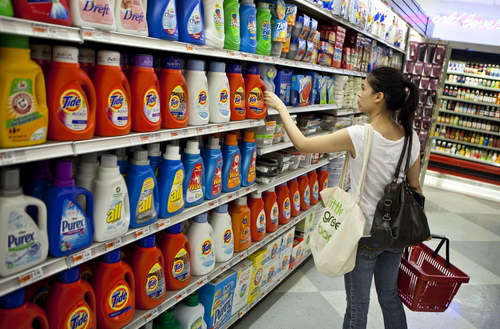P&G resumes sustainability scorecard for its key suppliers
Updated: 2011-07-18 13:13
By Huang Ying (China Daily)
|
|||||||||||
BEIJING - The world's largest consumer goods company Procter & Gamble Co (P&G) aims to further propel its measures to encourage the environmental performance of its key suppliers by continuing its suppliers sustainability scorecard this year.
The P&G suppliers sustainability scorecard was first designed in May 2010 and was implemented among about 400 suppliers and agencies around the globe who had the biggest impact on the consumer giant's business last year.
 |
|
A shopper reaches for Procter & Gamble Co Tide brand laundry detergent at a supermarket in New York. Procter & Gamble, the world's largest household-products maker, is taking measures to improve the environmental performance of its key suppliers. [Photo/Agencies] |
"This year, the scorecard program will be expanded to more than 600 suppliers and agencies and a number of adjustments have been made to ensure that it's easier to use for our suppliers," said Larry Loftus, director of global purchases capability & strategy, Procter & Gamble Co, who is also the scorecard's designer.
The scorecard reportedly relies on accepted worldwide measurement standards and sound science, including protocols from the World Resources Institute, the World Business Council for Sustainable Development and the carbon disclosure project, the company said.
Its objectives include enhancing supply chain collaboration and encouraging the sharing of ideas and capabilities to deliver more sustainable products and services to consumers.
There is an evaluation process within the scorecard that is able to assess the total environmental footprint of these suppliers, so long as they provide the data concerning energy use, water use, waste disposal and greenhouse gas emissions on a year-by-year basis.
According to feedback from suppliers from the first year's scorecard program, 81 percent of the participants responded and provided timely reports. They come from nine industries including financial services, chemicals, manufacturing, logistics and packaging. Of them there were 24 Chinese suppliers covering seven industries. The assessment results showed that, generally speaking, Chinese suppliers demonstrated above-average results in terms of environmental performance during the term.
The statistics also reflected that, compared with the previous year, 63 percent of suppliers reduced energy use, 64 percent of suppliers reduced greenhouse gas emissions and 62 percent of suppliers increased water use efficiency. At the same time, 38 percent of suppliers who responded provided sustainability innovation ideas and input.
"Through applying the P&G suppliers sustainability scorecard, not only did our business performance develop, but also so did our operational and environmental protection performances. All these improvements helped to sharpen our corporate's competitive edge," said Li Weixiong, president of Rising Display Products (Zhongshan) Co Ltd, a retail solution provider and manufacturer, which is in partnership with P&G in supplying display products.
The display products company's water and energy consumption dropped by 15 percent respectively year-on-year in 2010. Moreover, it co-created a highly efficient operational model with P&G that significantly reduced energy consumption as a result.
However, the scorecard is not unilaterally enforced by P&G. Instead, it is an open and collaborative model to drive sustainability and to encourage dialogue among suppliers and agency partners seeking suitable solutions.
"When we designed the scorecard, we wanted to create a platform that will encourage dialogue, but I didn't require them to report the dialogue to me," Loftus said.
P&G showed full respect to innovative ideas and solutions regarding sustainability put forward by its suppliers, and won't make them public unless they received the suppliers's approval.
"That's why we are trying to work with our suppliers' design teams to create a process to know what to share and what not to share, so we can be more public about the good ideas that can be shared more broadly," Loftus said.
As the designer of the scorecard, P&G is quite willing to promote it among other industries and enterprises, even those which have no business cooperation with us, and no fees will be charged.
"Since we launched the scorecard, we have received recognition from a number of organizations. We offered to share it with everybody and have made a lot of friends. From that perspective, it helps to build P&G's image quite well," said Loftus.